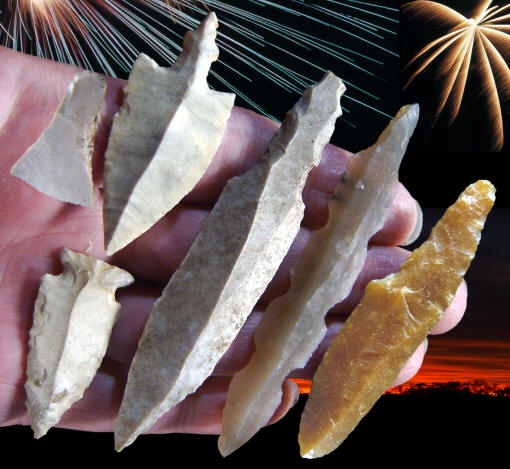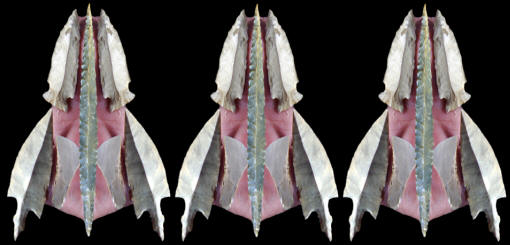|
"The long
parallel-sided flint blade became the hallmark of upper Paleolithic
stone tool technology. By means of indirect percussion, blades could be
peeled one by one from around the perimeter of surface of the prepared
core."---1983,
Herb C. Kraft & Gabriel DeCicco, "The Search For Humanity's Roots, A
Symposium And Exhibition" p. 40.
"The
development of blade flaking constitutes a crucial point in the history
of stone-working, for without it ancient technique would have been in a
cul-de-sac."---1970,
S. A. Semenov, "Prehistoric Technology, An Experimental Study Of
The Oldest Tools And Artifacts From Traces Of Manufacture And Wear," p.
44.
"----in the Americas, core technology means the production of flakes
or blades for tools."---1987,
Jay K. Johnson & Carol A. Morrow, "The Organization Of Core Technology,"
p. 1.
"(34,000
to 29,000 years ago) The Aurignacian
is clearly distinguished from Middle Paleolithic industries by a strong
emphasis on blade technology---."---1988,
Ian Tattersall, Eric Delson & John Van Couvering, "Encyclopedia Of
Human Evolution And Prehistory," p.
63.
"Blades:
Oblong, narrow flint flakes with almost parallel sides.---Irregular
blades are called flakes."---1948,
Therkel Mathiassen, "Danish Antiquities, Early Stone Age," p. 51.

PROJECTILE POINTS
MADE ON BLADES & FLAKES
AFRICA, BELIZE, FRANCE,
MEXICO,
NORTHERN EUROPE, PANAMA, UNITED STATES
Stone projectile points have been produced in every conceivable size,
shape and complexity by ancient cultures since the days of the
Neanderthals. Their design parameters range from simple unmodified
flakes to very elaborate bifacially flaked forms that exhibit the
highest degree of the flintknappers skill. Projectile points made on
blades and
flakes represent the simplest forms and they reflect an aura of
frugality, efficiency and utility.
|
|

CLICK ON PICTURE FOR LARGER IMAGE
PROJECTILE POINTS
MADE ON BLADES & FLAKES
AFRICA, BELIZE, FRANCE,
MEXICO,
NORTHERN EUROPE, PANAMA, UNITED STATES
This picture shows twelve examples of projectile points that were
made on blades and flakes. At least eight of them are made on
lamellar blades. They represent the simplest forms of finished
points. None of them are bifacially flaked. They all have at least
one intact flake removal scar on one side. Most of them were
edge trimmed into shape and both sides still retain their original
flake surfaces. The following is an inventory list of each point.
1. This edge trimmed projectile point
is from Panama. This point measures 3 3/16 inches (8.1 cm) long.
2. This is a transverse arrow point from northern Europe. These were
made from short segments of core blades. This point measures 1 7/16
inches (3.6 cm) long.
3. This edge trimmed stemmed arrow point was found on a site in
Denmark. It was made from a blade and measures 2 1/8 inches (5.4 cm)
long.
4. This Solutrean shouldered point was found in the Garrone River
Valley in southwestern France. It's a unifacially flaked point that
was made from a blade. Previous core blade removal scars are still
evident on one side. This very early projectile point dates to
sometime between 22,000 and 18,000 years ago. It
measures 2 7/8 inches (7.3 cm) long.
5. This Mayan projectile point was found on a site in Belize. It's made of Colha chert and most of the
edges still remain sharp from the original flake. This point
measures 3 11/16 inches ( 9.3 cm) long.
6. This Obsidian side-notched projectile point was probably once
attached to a dart or spear. It was collected on a site in either
Mexico or Belize. It was made from a large blade. This point
measures 4 3/8 inches (11.1 cm) long.
7. This three sided blade
point was found on a site in northern Europe on the Island of Lolland
in Denmark. It dates to the Neolithic period sometime before 2200
B.C. It was made from a long narrow blade that was struck off a
prepared core. Two sides and more than half of the third side was
skillfully pressure flaked into a three sided point.
8. This projectile point dates to the Neolithic period and it was
collected on a site in Denmark. It was made on a slightly curved
blade that was edged trimmed with large notches and a stem for
hafting. It measures 3 1/2 inches (9 cm) long
9. This "shouldered" arrow point is believed to have been found on a
site in northern Europe. It was made on a blade that was edge
trimmed into shape. It measures 2 1/4 inches (5.7 cm) long.
10 & 11. Both of these points were collected on sites somewhere in
one of the countries in
the Sub-Saharan
region of Africa. They were both expertly made from flakes that were
struck from cores. The cores were pre-shaped so a pointed triangular
flake could be removed that did not require any further edge
modification. The larger example measures 2 1/2 inches (6.3 cm)
long.
12. This side-notched Klunk point was found on a site in southern
Illinois. It was made on a flake that was struck from a prepared
core. Klunk points are the oldest dated arrow points from this area. |
|
|
"Minimal modification" are two words that best describe why
so many ancient cultures made their projectile points on blades or
flakes. Once a blade or flake is produced from a core it only takes a
minimal amount of time to modify the edges by pressure flaking to
produce a projectile point. Blades and flakes were also used to produce
several different types of cutting, scraping, engraving and piercing
tools. |
|
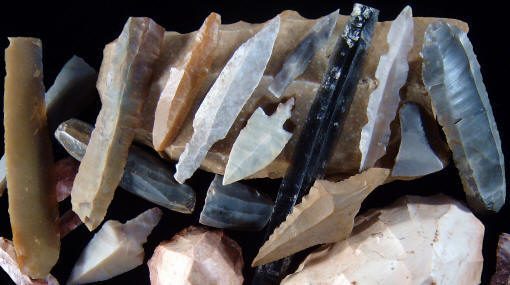
CLICK ON PICTURE FOR LARGER IMAGE
PROJECTILE
POINTS, BLADES & CORES
AFRICA, BELIZE, FRANCE,
MEXICO,
NORTHERN EUROPE, PANAMA, UNITED STATES
This
picture shows a wide range of core and blade related artifacts. All
of the projectile points were made from blades or flakes that were
struck from prepared cores. These artifacts were collected on sites
located in many different countries. This picture also shows several
examples of long narrow blades and different examples of cores. The
largest core is from France and the smaller cores were found on Neolithic sites in northern Europe and on
Woodland sites in Illinois. |
|
|
Most of the projectile points illustrated in this report were
made from long narrow lamellar blades that were struck from prepared
cores. The technique was well established during the Aurignacian period
in Europe approximately 34,000 years ago. Blades were removed using
indirect percussion by striking a punch with a hammerstone. |
|
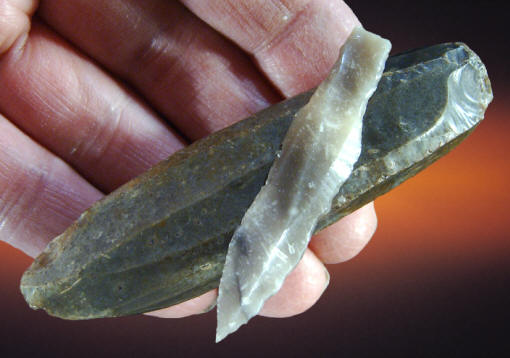
ARROW POINT & CORE
NORTHERN EUROPE
This picture shows a small
core and a point that were collected on sites in Denmark. They
illustrate the similarity of the long narrow flake scars of one to
the other. The arrow point was struck off a similar size core. The
blade was simply trimmed along the edge to form a stemmed arrow
point. The blade measures 2 1/8 inches (5.4 cm) long. |
|
|
The earliest prepared core technology dates to sometime
before 200,000 years ago on some Old World Early Paleolithic sites. The
process was named Levallois after a suburb in Paris where cores and
flakes of this type were first discovered. Levallois cores produced
flakes rather than blades. Levallois flakes can be comparatively uniform
in shape and range in size up to 6 inches (15.2 cm) long but they do not
have the long narrow parallel sided shape of blades. Their length to width ratio do not
consistently fall within the defined
parameters for blades. |
|
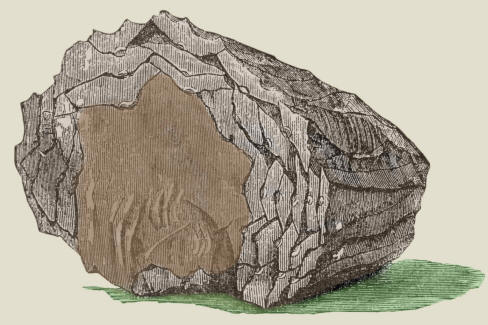
COMPUTER COLORIZED DRAWING OF CORE
FROM 1898 "ANNUAL REPORT
OF THE BOARD OF REGENTS OF THE SMITHSONIAN INSTITUTION
DRAWING OF REFITTED BLADE CORE
BRANDON, ENGLAND
This illustration is a
color enhanced drawing of a core from Brandon, England. It
illustrates how the blades can be refitted back onto the core.
Wilson describes it as: "The flakes have been struck off, one after
the other, going around the outer edge, gauging the proper thickness
for the flakes, the inside of one forming the outside of the next.
With patience one can rearrange the flakes one by one against the
core in the inverse order in which they have been struck off until
the nodule is reconstructed." |
|
|
Blades are described as flakes that are at least twice as
long as they are wide. Their sides are usually straight and parallel.
One side also usually shows the scars where other long narrow blades
were previously removed. |
|
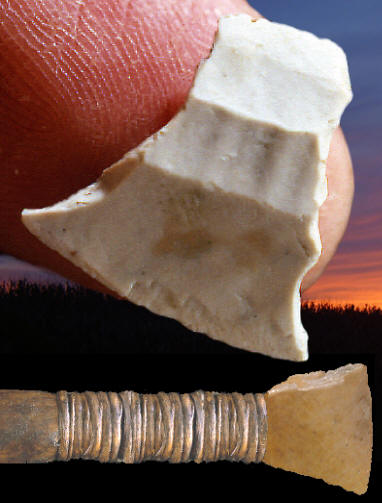
TRANSVERSE ARROWHEAD
MESOLITHIC & EARLY
NEOLITHIC PERIOD
NORTH AND WESTERN EUROPE
This picture shows an example of a transverse arrow point above and
a computerized image of how it was hafted below. These unique points
were made from short snapped off segments of large core blades. This
point is actually wider than it is long. The
wide edge, which is the original core blade's edge, is the end of
the arrow point that would pierce the intended target. This edge
measures almost 3/4 of an inch (1.9 cm) wide. This point is made of
what appears to be Danish flint. It measures 11/16 of an inch (1.7
cm) long. |
|
|
The earliest projectile points made on flakes are the North
African Aterian points (est.
40,000 TO 30,000 years ago) and Old World Mousterian points (est.
120,000 to 35,000 years ago). Both of these
types were made on Levallois flakes. In fact, many Mousterian points were
made on pre-shaped Levallois cores that produced a wide point that did
not need any further secondary edge trimming. This innovative technique
of pre-shaping a flake on a core is thought to be an important
development in human-cultural evolution. |
|
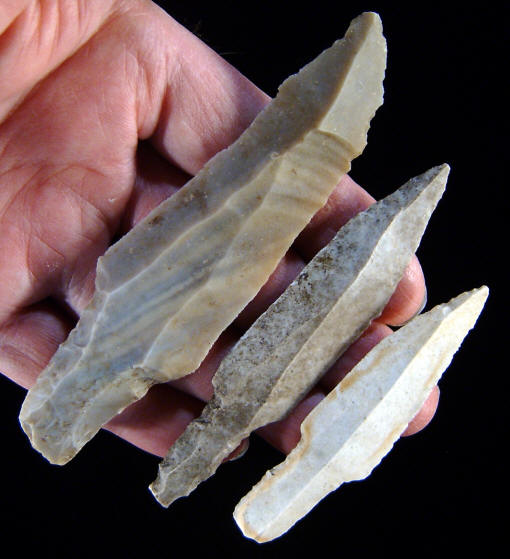
MAYAN STEMMED BLADE PROJECTILE
POINTS
MAYA
CULTURE---BELIZE
CLASSIC PERIOD
These small stemmed blades began
to be produced about A.D. 800 to A.D. 900 during the Terminal Classic
Period. It was about this time that Mayan warriors began to use
atlatl thrown spears tipped with small stemmed points made from blades. The stone
tool makers of northern Belize made them by the tens of thousands to
supply the needs of this new weapon. They are miniature versions of the
large stemmed macro blades.
After these blade were removed from the core the
stem was edge trimmed into shape by pressure flaking plus some minor
edge trimming by pressure flaking to complete the point. The two
points on top are made of Colha chert. The center point measures
3 11/16 inches (9.3 cm) long. |
|
|
Projectile points made on blades are well established by the
Upper Paleolithic Gravettian culture between 30,000 and 27,500 years
ago. Most of the projectile points made on Aurignacian sites were made of
antler, bone and ivory. |
|
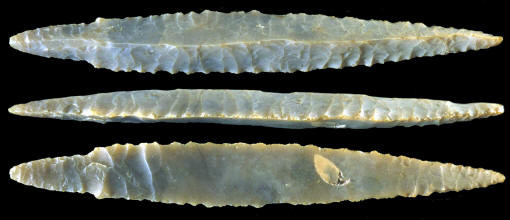
CLICK ON PICTURE FOR LARGER IMAGE
THREE-SIDED PROJECTILE
POINT
MADE ON A BLADE
DENMARK
This three sided blade arrow point was found on a site in northern Europe
on the Island of Lolland in
Denmark. It dates to the Neolithic period and was
probably made sometime before 2200 B.C. It was made from a long narrow blade that was struck
off a prepared core. Two
sides and more than half of the third side was skillfully
pressure flaked into a three sided point. This arrow point is
made of Danish flint and measures 3 11/16 inches (10 cm) long,
1/2 inch (1.2 cm) wide and 1/4 inch ( 6 mm) thick. |
|
|
There is no lithic tradition in the Canadian or United States
archaeological record that describes a lithic industry that
traditionally produced projectile points on blades. Most of the
projectile points from these North American countries were bifacially
flaked. Only a small percentage were made on simple edge trimmed flakes
or flakes that have a limited amount of surface flake removals. One example from Illinois
is illustrated in this report. It's a side-notched point that appears to
be a late Woodland Klunk point that are reported to be the earliest
arrow points from that area. It was made on a flake that was only edge
trimmed. But one side does show two previously removed flakes that
indicates some uniformity in a flake production process, as if the flake
was removed from a prepared core. Klunk points were made on simple flakes that
were often only edge trimmed but they were not made on blades. |
|

AMERICAN MUSEUM OF NATURAL HISTORY COLLECTION
CLICK ON PICTURE FOR LARGER IMAGE
SOLUTREAN
SHOULDERED POINT
MADE ON BLADE
FUMEL SITE,
FRANCE
This Solutrean shouldered point was
found on the Fumel site in the Garrone River Valley in southwestern
France. It's a unifacially flaked point that was made from a blade.
Previous core blade removal scars are still evident on one side.
This very early projectile point dates to sometime between 22,000
and 18,000 years ago. It
measures 2 7/8 inches (7.3 cm) long. |
|
|
This report also illustrates projectile points from Mexico
and Belize that were obviously made on blades. The Obsidian and chert
sources from these regions are very large. So it's not surprising that
lithic traditions evolved into large core blade production industries.
The Mayan blade projectile points, made from Colha chert in Belize, are
miniature versions of the much larger
macro-blade daggers that
can reach well over 15 inches (38 cm) long. In the central valley of
Mexico huge numbers of long Obsidian blades were produced. Some of these
were apparently notched for spears or darts. |
|
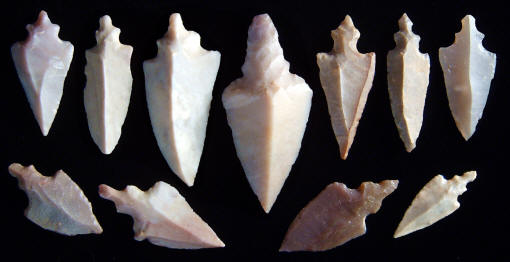
CLICK ON PICTURE FOR LARGER IMAGE
PROJECTILE POINTS
MADE ON FLAKES
SUB-SAHARA AFRICA
All of these arrow points were made
from pre-shaped cores. They are strikingly similar miniature
versions of the large
macro blade Mayan daggers. All of
these points were collected on sites in one of the countries in
the Sub-Saharan
region of Africa. They were expertly made on flakes that were struck
from cores. The cores were pre-shaped so a pointed triangular flake
was produced that did not require any further edge
modification. The largest example measures 2 1/2 inches (6.3 cm)
long. |
|
|
In Panama there was a lithic industry that produced three
sided projectile points with one side on many of them left unaltered with the
original flake surface left intact. Some of them show previously removed
flakes that indicate they may have been produced from prepared cores.
They can vary in size to below one inch to above 4 inches long. Holmes
describes them as arrow points but some examples seem to be large enough to have been
dart/spear points. |
|

PROJECTILE POINTS
MADE ON BLADES
PANAMA
These four three
sided stemmed points were collected on sites in Panama. William H.
Holmes describes these forms of projectile points from an area north
of the canal. The surface of two of these points are flaked on two
sides and have a smooth flake surface on the third side. The other
two examples have very little edge trimming. The flaking is rough and appears to be mainly done with
percussion flaking. The larger examples would probably have been
used on the ends of spears and thrown with atlatls (spear throwers).
The smallest example may have been used to tip the end of an arrow.
Holmes describes the material they are made from as a flinty jasper
of reddish and yellowish hues. The points in this picture range in
size from 2 1/4 inches (5.7 cm) long to 3 13/16 inches (9.7 cm)
long. |
|
|
Northern Europe produced projectile points from Danish flint on blades
in the form of edge trimmed blades, transverse points made from short
segments of blades and three-sided points. The large flint sources in
this region of the world was the catalyst that encouraged the
development of technologically advanced core and blade production
industries. |
|
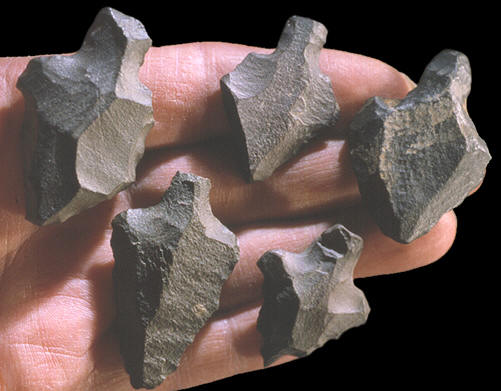
CLICK ON PICTURE FOR LARGE IMAGE OF ONE POINT
ATERIAN
POINTS MADE ON LEVALLOIS FLAKES
MOROCCO
These five tanged Aterian points are reported to have been collected
on sites in southern Morocco. They were made from simple thick flakes struck from
Levallois cores. The Aterian culture dates to the late middle
Paleolithic period, sometime before 40,000 years ago and came to an
end about 30,000 years ago. Aterian points were developed out
of the Mousterian stone tool industry characterized by Levallois
technology. Tanged Aterian points are very heavy duty projectile points. The smaller
examples (they are reported up
to
8 or 9 inches (20 to 22 cm) long)
are
believed to have been hafted onto darts or spears that were thrown
by atlatls (spear throwers). These points were used to hunt large
grazing animals such as white rhinoceros, extinct
camels and large bovine and smaller animals like gazelle, fox,
jackal, warthog, antelopes and ostrich. The points illustrated here appear to be
made of Basalt or Rhyolite. The smallest example in this group
measures 1 1/2 inches (3.8
cm) long |
|
|
The oldest illustrated projectile point in this report
that was made on a blade is a Solutrean shouldered point. It was discovered on
the Fumel site in southwestern France and dates to sometime between
22,000 and 18,000 years ago. This unifacially flaked stemmed point was
made from a blade that was struck from a prepared core. The scars from
previously removed flakes can be seen on one side. |
|
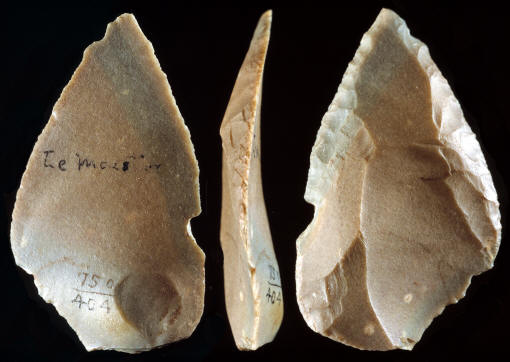
AMERICAN MUSEUM OF NATURAL HISTORY COLLECTION
CLICK ON PICTURE FOR LARGER IMAGE
MOUSTERIAN POINT
LE MOUSTIER
SOUTHWESTERN FRANCE
This point was collected on the
Mousterian type site of Le Moustier in southwestern France on the
Vezere River. It was made from a flake that was struck from a
Levallois core. Most of the bulb-of-percussion is still intact. The
only additional shaping to the flake, after it was removed from the
core, was some minor edge trimming. This point dates to sometime
between 120,000 and 75,000 years ago. |
|
|
The world's most prolific core and blade production sites occurred on
locations near large outcrops of high quality cherts and Obsidian. These
quarry sites offered flintknappers such a large
supply of material they must have been encouraged to experiment. Some of
the most exotic lithic artifacts ever produced come from these sites,
such as the many different varieties of Neolithic daggers from northern
Europe or the large macro-blade daggers and eccentrics from Belize. But
these abundant lithic sources also seem to have universally encouraged
core and blade production as the most efficient way to make their tools.
Large blades were produced in extraordinary numbers in Mexico near
sources of Obsidian, in Belize near the Colha chert quarries, in
northern Europe near the Danish flint outcrops, and France from Grand Pressigny and other flints. |
|
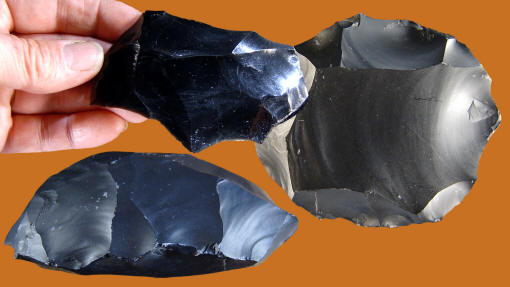
LEVALLOIS BLADE AND CORE
CAST FROM EXAMPLES MADE BY
ERRETT CALLAHAN
This picture shows three views of a
cast of a Levallois core and blade that was made by Errett Callahan.
These cores are also sometimes referred to as tortoise cores because
they look so much like a tortoise shell. The earliest prepared core technology dates to sometime
before 200,000 years ago on some Old World Early Paleolithic sites. The
process was named Levallois after a suburb in Paris where cores and
flakes of this type were first discovered. Levallois cores produced
flakes rather than blades. Levallois flakes can be comparatively uniform
in shape and range in size up to 6 inches (15.2 cm) long but they do not
have the long narrow parallel sided shape of blades. Their length to width ratio do not
consistently fall within the defined
parameters for blades. |
|
|
The production of flake tools over bifacially flaked tools has some
definite advantages. The process can be quicker than bifacial flaking
which produces many more waste flakes than an edge trimmed blade or
flake. Prepared core technology is the most
efficient projectile point manufacturing technique that can be used to produced the sharpest
cutting edges with a single blow from the core. In many cases all that
was needed to finish the point was to alter the basal edges for hafting.
In the end, all that is really needed is a projectile point with a sharp
point and edges that can pierce the hide of a animal. It's amazing how
some cultures chose to make such simple but effective projectile points
on blades or flakes while other cultures chose to make extremely
complicated bifacially flaked and fluted points like the Folsom points. |
|
"REFERENCES"
1898, Wilson, Thomas, "Annual Report
Of The Board Of Regents Of The Smithsonian Institution,"
Prehistoric Art, p. 427.
1948,
Mathiassen, Therkel, "Danish Antiquities, Early Stone Age," p. 51.
1970,
Semenov, S. A., "Prehistoric Technology, An Experimental Study Of
The Oldest Tools And Artifacts From Traces Of Manufacture And Wear," p.
44.
1983,
Kraft, Herb C. & DeCicco, Gabriel, "The Search For Humanity's Roots, A
Symposium And Exhibition" p. 40.
1987,
Johnson, Jay K., & Morrow, Carol A., "The Organization Of Core
Technology," p. 1.
1988,
Tattersall, Ian, Delson, Eric & Couvering, John Van, "Encyclopedia
Of Human Evolution And Prehistory," Aterian, Aurignacian,
Blade, Levallois, pp.
62, 63, 94, 319.
|
|
RECENT
LISTINGS HOME
ORDERING |
